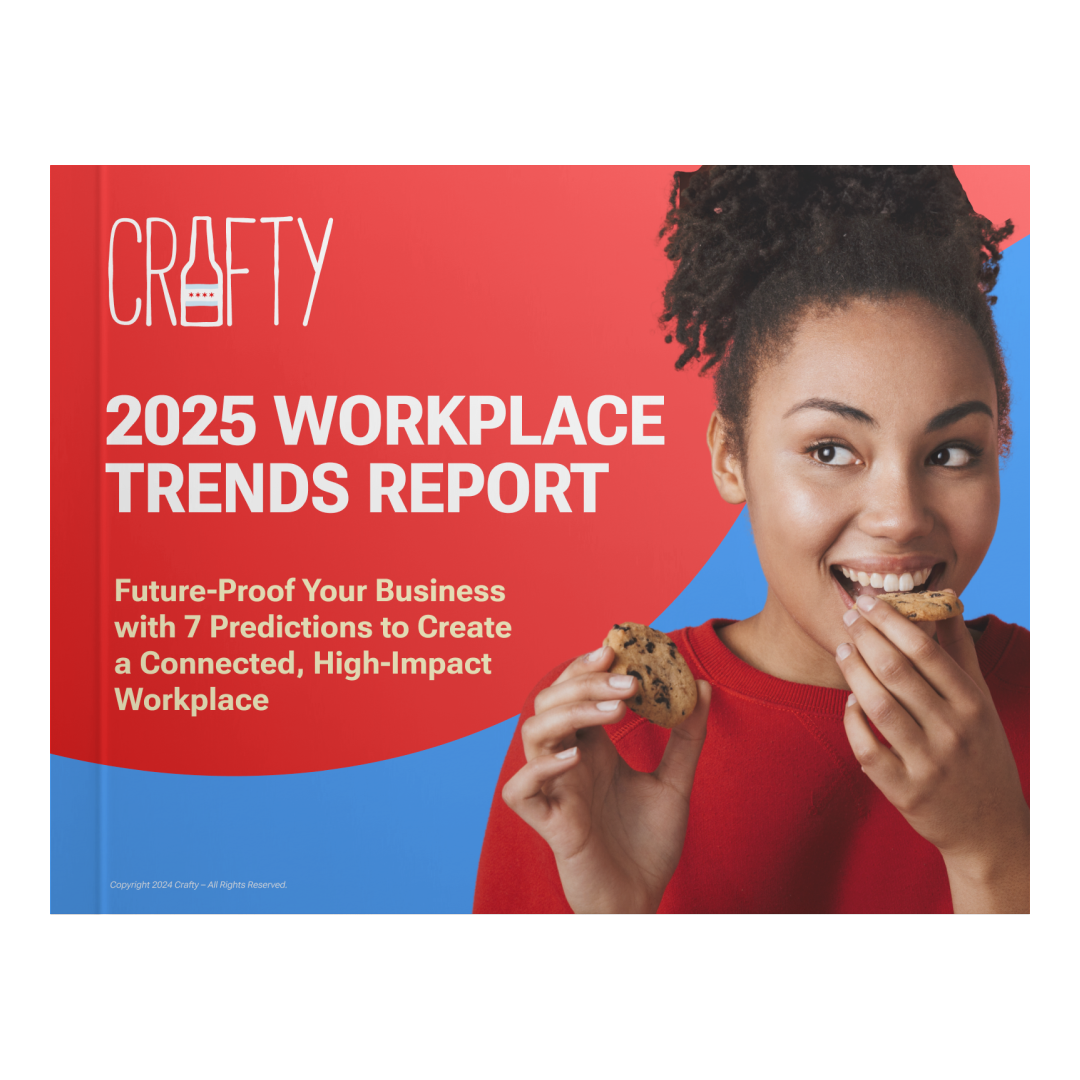How to Ace Employee Engagement
✍️ Written by Amber Alston & Amy Rigby
🕚 6-Minute Read • Updated Monday, January 27, 2025

If the rapidly dropping temps and sudden influx of strategy meetings on your calendar weren’t a dead giveaway, 2024 is just around the corner. That means, it's time for office leaders like you to get the lowdown on the social and economic trends that will keep your employees engaged in the coming years. If you're on the hunt for ways to boost your team's motivation, you've got company. After a year that felt like an endless obstacle course – from the pandemic to tech layoffs, labor shortages, economic uncertainties, and skills gaps – leaders everywhere are facing the challenge of keeping their workforce energized and involved.
But, first things first, what is employee engagement? Gallup says it’s “the involvement and enthusiasm of employees in their work and workplace.” Sounds simple, right? Well, not so much in today's fast-changing work scene. Good news is, there are some proven tricks to crank it up.
So, if you're worried that employee enthusiasm might fizzle out instead of sizzle in the next year, we've whipped up a quick guide to the trends and tactics. Check out these top employee engagement trends for some inspiration on what to try out in your workplace next.
2025 WORKPLACE TRENDS REPORT
7 PREDICTIONS TO FUTURE-PROOF YOUR WORKPLACE
Discover seven research-backed predictions and actionable strategies to transform your workplace into a connection catalyst that drives meaningful results.
1. After flip-flopping on remote and hybrid, companies are striking a compromise with structured hybrid work.
For years, the office was the heart of work life—a place where teams collaborated, ideas flourished, and culture thrived. Then, almost overnight, everything changed in 2020. Remote work became the norm, and the office as we knew it faded into the background. By 2024, as companies sought to bring employees back, hybrid work emerged as the solution—but not without growing pains. The year was chaotic, marked by trial and error as organizations and employees struggled to define what “going to the office” even meant.
Hybrid work has since found its footing. Once seen as a temporary fix, it’s now the dominant model for engaging and retaining employees according to Forbes:
- 68% of U.S. employers offer some form of work location flexibility.
- 43% of U.S. firms now have structured hybrid models.
- The percentage of companies requiring 3 days per week in office has increased from 19% to 28%.
- 79% of companies prefer to go for setting a minimum number of days per week.
Exceptional workplaces, like those recognized by Gallup’s Exceptional Workplace Award, have found success by listening to employees and creating “flexibility within a framework.” BBVA, for instance, surveyed its team and discovered 92% preferred not to return to fully in-person work. The result? A hybrid model that balances 60% in-office work with 40% remote, fostering a healthier work-life balance while meeting business needs.
2. Investments in wellness and mental health support aim to offset burnout.
Noticing the weary eyes, slumped shoulders and lackluster energy around the office? As employees reel from record burnout levels and continued economic uncertainty, employers are taking renewed interest in physical and mental wellness initiatives. According to a Gympass survey of 2,000 HR experts, 90% of companies see a positive ROI with their wellness initiatives.
Wellness has many aspects, of course. Here are some of the top employee engagement trends for taking care of your people:
- Mental health: 19% of employers still offer paid mental health days, and therapy and coaching have become expected employee benefits. Delta Air Lines, for instance, increased its free counseling sessions from seven to 12 per year for Delta employees and their household members as part of the company's new "wellbeing-focused people strategy."
- Physical fitness: Microsoft offers employees a wellness reimbursement that increased from $800 in 2021 to $1,500 in 2022. Intuit offers wellness coaches and an activity program that rewards employees for practicing healthy habits.
- Nutrition: Another component of both physical and mental health is the food we fuel with. Companies wanting to attract more workers back to the office and give them the nutrition to keep their bodies and brains energized are investing in creating healthy food and beverage programs.
Just look at Ferrara. By partnering with Crafty to build a kitchen and pantry program in its new headquarters, Ferrara is now able to provide healthy food to all its employees, taking into account dietary restrictions among other things.
"We were having allergen issues, variety, and quality issues," says Amanda Loudermilk, Ferrara’s Workplace Manager. “Our team is passionate about eating healthy, and Crafty partnered with us to drill down into what would be great quality options that fit our budget.”
3. Companies are now more focused on integrating Diversity, Equity, and Inclusion (DEI) into every department.
While 2020 began the surge of DEI hiring, it might be slowing down. According to LinkedIn, chief diversity officers had the fastest hiring growth in the C-suite in 2020 and 2021 but declined in 2022. Now, it seems that companies are more focused on integrating DEI into their culture, rather than seeing it as a separate initiative.
As DEI consultant Ivan H. Lee writes, “Ideally, DEI is embedded in every department. The outcome is that the DEI department does not need to exist. As equity is achieved, there is less need for a standalone department to oversee it.”
He shares the sentiments of Francisco Tezén, the CEO of A Better Chance, an educational nonprofit that integrates DEI into its culture.
“It's not a discrete, separate DEI roadmap," Tezén tells Business Insider. "It's about fundamentally who you are, what you do, and what you value, and then to what extent are you willing to marshal and make investments that are long-standing in the same ways that if you're launching products or you're launching services there are startup costs that you're not expecting to recoup immediately."
While having a DEI team is a great start, consider creating DEI goals for every team in your organization so that everyone shares responsibility for diversity, equity, and inclusion.
4. Employers see Learning & Development as a key retention strategy.
With employees craving career growth and employers fighting a labor shortage and skills gaps, L&D has become more critical than ever. In fact, LinkedIn's 2023 Workplace Learning Report identified "providing learning opportunities" as the number one employee retention strategy.
Why has L&D become the apple of the corporate world's eye? Let's start with the employees. They're itching for growth, hungry for knowledge, and thirsty for opportunities to show their merit. They're not just working for the paycheck anymore. They're chasing personal and professional development, and they're looking to their employers to provide that.
Just take a look Nationwide. The insurance company is an 11-time winner of the Gallup Exceptional Workplace Award. In 2022, Nationwide reached its highest level of employee engagement, and L&D is a part of its employee engagement strategy. Through its Nationwide Educational Assistant Program, employees can get up to $5,250 each in reimbursement for college degrees, certifications, and technical insurance courses. Additionally, the company provides upskilling courses, including courses specifically aimed at improving customer experiences.
5. AI and other technology enhance the employee experience.
AI, particularly ChatGPT, has been all the rage lately, but how can you leverage it and other intelligent solutions to boost employee engagement? There are two levels to this. One, people leaders can use employee engagement software that leverages AI to gauge employee sentiment and engagement. For example, in 2023, Microsoft launched Copilot, an AI tool that uses large language models (LLMs) to help leaders engage their teams.
Two, by equipping your employees with AI and other cutting edge technology that make their jobs easier, you can boost engagement. An example of this would be providing office managers or workplace teams with a technology platform like Crafty to manage and scale a food & beverage program that leaders and employees alike love.
Picture this. Your office managers or workplace teams, armed with a technological platform like Crafty, can manage f&b operations from end to end - from the CEO to the intern. Crafty is an example of how intelligent tools can revolutionize mundane tasks. It provides a centralized online platform to manage everything from budgeting to inventory, ordering, and what's more, it can even learn from employee choices to make smart recommendations. Cool, right?
Talk to your employees—through pulse surveys, focus groups, and one-on-ones—to find friction points that could be eased through the use of technology.
What you can do to harness the power of 2023’s top employee engagement trends
With all the employee engagement trends out there, figuring out how to integrate them into your organization can be overwhelming.
If you’re struggling with where to start, figuring out how to get employees to want to come into the office seems to be the central theme of 2023. How can you mandate a return to office while still giving your employees autonomy and choice?
“If you have to take away your employees’ choice about where to work, you have to balance that out by giving them abundant choices in other areas,” Melanie Prengler, a University of Virginia assistant professor who studies hybrid and remote work arrangements, tells Quartz.
Many companies have discovered the strategy of luring workers back to the office by providing unparalleled food and bev experiences. Think in-office cafes and fully-stocked pantries with every employee’s favorite snacks. Give your teams an abundance of f&b choices, and they won’t want to stay home and miss out.



![Crafty strategies of employee engagement ebook [2025] Crafty strategies of employee engagement ebook [2025]](https://info.craftydelivers.com/hubfs/Crafty%20strategies%20of%20employee%20engagement%20ebook%20%5B2025%5D.png)
